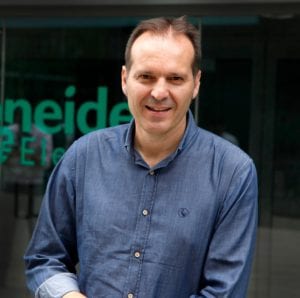This blog post was co-authored with Natasha Nelson, Schneider Electric Chief Technology Officer for Services, Cyrille Huguet, EcoStruxure Power Analytics & AI Director, and Ali Abbas, AI Product Management Director.

We’re developing new tools to support our customers in the face of growing global challenges in electrical asset and systems management.
A world where electricity is set to become the dominant power source is creating big changes in the field of energy management. According to the International Energy Agency, the share of global energy use met by electricity will need to increase by 4% a year to 2030 to get on track with net zero targets. This rising demand, increasingly reliant on less predictable renewable sources, will lead to many new challenges for businesses who manage electrical assets.
Widespread electrification is also creating an unprecedented need for Schneider Electric’s services. We can’t simply scale up our capacity overnight: our understanding of the industry is gained through years of experience. But we can help our services teams deliver more value to customers. That’s why our next generation service plans, like EcoCare*, now incorporate the latest developments in AI technology. By making use of generative AI’s impressive capacities, we can provide actionable insights with greater speed and precision, supporting efficient, data-driven decision-making. Here are three ways our experts are now using AI’s ‘new kid on the block’ to become superheroes.
1. Drafting predictive maintenance recommendations
Building upon our generative AI capabilities, the focus was our Connected Services Hub – a team of expert engineers who offer remote advice and support to customers managing critical electrical assets around the world. As well as troubleshooting urgent issues, the hub’s experts also produce a range of technical reports with advice and insights on optimizing power system management. The reports help customers take care of their electrical assets more proactively and efficiently. But since they’re based on extensive data and analytics, producing them manually takes considerable time.
Using generative AI, we’ve now developed a tool that can automatically produce a draft of bespoke recommendations to include in the reports. These are tailored to each individual site, and the specific situations there at any given time. The technology could generate detailed, step-by-step instructions, for example, to help a customer investigate a concern about a particular piece of equipment in their power system. The recommendations are based on monitoring information from our IoT-connected sensors, and insights from our digital analytics. And crucially, they’re underpinned by a powerful Schneider Electric knowledge database, developed by our top experts. To ensure accuracy, all the recommendations are reviewed and endorsed by our engineers before we send any report to a customer.
During the few months we’ve been using this generative AI-based tool, it’s received highly positive feedback from the engineers involved in its implementation. They say it’s helping them produce higher quality reports with greater consistency and speed – on average, halving the time they spend writing reports.
2. A new virtual expert
Even more recently, we’ve begun using generative AI to develop a completely different tool: a virtual expert that our staff experts can consult to support their work. By now, many people are familiar with chat-based AI interfaces that can provide detailed, conversational responses within seconds on a wide range of topics. We’re building on this kind of technology to provide an internal expert resource focused specifically on electrical asset management.
Even experts have questions sometimes. They might want to check what technical standards apply in a specific part of the world, or the specifications of a particular type of circuit breaker, for example. Now, rather than consult a library, the internet or a colleague, they can turn to our very own virtual expert. It might look like an unassuming chatbot. But we’ve carefully trained the tool using our deep technical know-how – product documentation, white papers, instruction manuals – and industry understanding, to make sure it provides useful, accurate answers.
We worked closely with our human experts to provide the right learning material for the tool. And since it went live earlier this year in our Connected Services Hub, we’re now using their feedback for fine-tuning before making the resource available to other teams across the company. The virtual expert cites its sources to help ensure transparency. And of course, humans always have the final say.
3. Summarizing insights more efficiently
The recommendations we discussed above aren’t the only way that AI is helping our Connected Services Hub experts provide a better service to customers. We’ve also developed AI-powered technology to automatically summarise the maintenance early warnings coming from our sensors and analytics into a digestible format, and translate this into different languages where necessary. This helps our engineers get straight to the heart of the relevant issues in their reports – offering authoritative insights and actionable advice.
This tool uses an established form of AI, called natural language processing, to distil the wide range of measurements and alerts from the system into a few clear paragraphs, specific to the customer’s individual context. It also incorporates generative AI to ensure the appropriate tone of voice is used. Once the summary is produced, our experts can choose to translate, shorten or expand it at the click of a button. They then review and approve the content before incorporating it into the final report.
As with our other AI resources, the power here lies in combining new developments in technology with Schneider’s specialist knowledge. If we relied only on ‘off the shelf’ solutions, the content produced even by the latest AI would be too generic to be useful. So we’ve drawn on our expertise both in data science and energy management to train equally powerful algorithms, but with a focus on our particular area of work. This means the output is accurate and specific enough to make a real difference.
From experts to superheroes
The tools we’ve discussed here enable Schneider’s services experts to offer unbeatable value to customers, by combining their knowledge and creativity with AI’s analytical and automation capabilities. They’re helping our service teams work faster, more accurately and with greater confidence. And as demand for our services grows, they’re also allowing us to bring new members on board at the speed required. Our engineers are already leaders in their field. With generative AI, they can become superheroes.
Given its potential, it’s not surprising that AI technology is seeing rapid growth among forward-looking businesses. Analysts at LNS Research have found that performance excellence leaders are more than twice as likely to use AI to predict failures than followers. Niels Andersen, the firm’s principal research analyst, told Schneider Electric he expects the adoption of generative AI to “grow rapidly”, highlighting its potential to help businesses manage the inherent unpredictability of many renewable power sources, such as solar and wind.
“You cannot plan the weather, but you can prepare for it,” says Andersen. “Generative AI can encapsulate electrical system knowledge, optimizing and simplifying maintenance and operations, to be better prepared for the unpredictable.”
As Schneider’s use of generative AI develops, we involve the teams who will be using the tools at every stage, from training the algorithms to overseeing their implementation and reviewing the results. This agile approach means we can constantly refine and improve our solutions as we gradually embed them across the company, ironing out any issues that emerge. As we do so, we prioritise providing a good user experience for our staff, to encourage strong take-up and a constructive dialogue.
And we have clear policies in place to address potential risks. Last year, a McKinsey survey found that inaccuracy was the most commonly cited risk associated with generative AI – seen as more relevant than cybersecurity and regulatory compliance. Despite this, less than a third (32%) of businesses implementing AI were mitigating against it. At Schneider we buck this worrying trend, backing up our iterative design processes with formal safeguards to ensure both accuracy and transparency. We use a matrix system to assess the performance of all our AI tools. And their output is always validated by a human before being offered to customers. As a further check, we work out the computational power required for any use of AI before deploying it – because what’s the point in a solution that uses more energy than it saves?
Measures such as these, and Schneider’s experience in providing electrical services, mean businesses can have confidence we’re getting the best out of AI for them. “AI is a powerful technology,” explains Schneider Electric’s chief AI officer Philippe Rambach, “but the real value comes from combining its capabilities with human expertise.” Every superhero knows that with great power comes great responsibility. That’s why, as we develop our use of generative AI, we include the input of our industry-leading engineers throughout the process. In this way, we’re supporting our teams to maintain and deepen their customers’ trust – becoming not just superheroes, but responsible superheroes.
* Please verify the availability of EcoCare in your region through a local services sales representative. If EcoCare is not yet available, you can start leveraging EcoStruxure Service Plan.




Add a comment